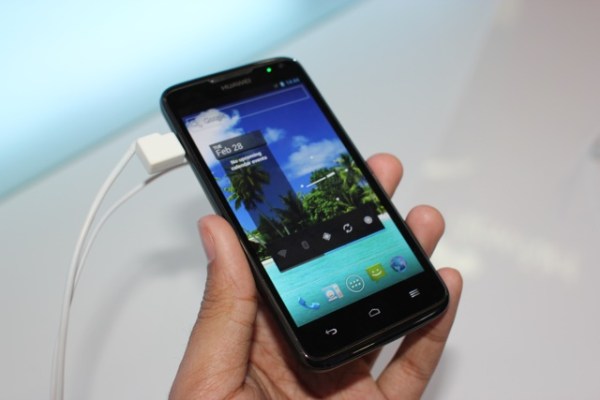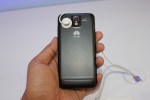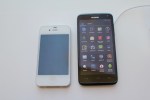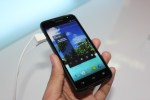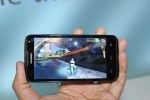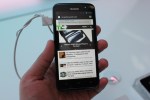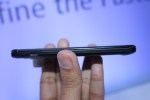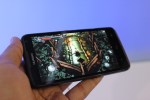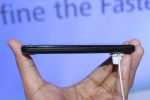After hearing that Huawei had revealed “the world’s fastest smartphone” in the form of the Ascend D Quad, we knew we had to seek it out. Well, we finally managed to score a little hands-on time with the Chinese company’s newest device, and we didn’t come away disappointed.
The D Quad is a handsome, understated device, and it feels great too: the device’s back is covered in a slick, soft-touch plastic, and it fits nicely in my hand despite its 4.5-inch 720p display. It’s not even close to being the most ostentatious phone I’ve seen in my days in Barcelona, but Huawei’s design team livened things up a smidge with some red highlights along the device’s rear. It’s clear that in their push for U.S. and global relevance, they’re making sure that the fit and finish of their devices is up to snuff — good on them.
To my pleasure, the Ascend D Quad was running stock Ice Cream Sandwich — not a single modification was made from what I could tell, and when combined with Huawei’s seemingly formidable 1.5 GHz K3V2 processor, swiping across homescreens, app pages, and websites was no big thing. What’s more, the D Quad also performed admirably when it came to games like Riptide GP, although I’m sure Huawei knew that would be the case when they preloaded it on their devices. Still, horsepower is horsepower, and the D Quad seems to be doing just fine on that front.
And it’s a good thing, too. With Huawei preparing to enter the U.S. market shortly, the D Quad is exactly the sort of device they should have at the ready. And in fact, that’s exactly what’s going to happen — the device will be released in North America as well as all the other usual markets in Q2 of this year. The big question is if anyone will actually buy one.
While the company has recently doubled their market share in China, Huawei has little (if any) brand power in the United States — in order to really make the dent in the market they hope for, it’ll take gobs of money, manpower, and marketing to push past (or even just run alongside) more prevalent brands like LG or Samsung. It’s going to be an uphill battle for Huawei — they’ll have to fight to break out of the low-price, low-end handset niche they’ve managed to carve for themselves.
Having only seen Huawei handsets occupying the lowest possible rung at my local big box electronics store, getting the chance to play with a seriously respectable Huawei phone was something of an eye-opener. I get the feeling it would be for more than a few consumers too, provided Huawei could get their hardware in front of people’s eyes. Still, I get the impression that transforming their brand isn’t exactly the only thing Huawei has to worry about.
Now that people are more aware of how smartphones are produced, I can’t help but wonder what sort of effect Huawei’s Chinese roots will have on their U.S. market push. Even the name could be problematic: I’ve met more than a few people who couldn’t wrap their tongue around the name, with “Wowie!” being one of the most common pronunciations I’ve heard. We’ll soon see how Huawei’s latest and greatest fares here in the States, but hopefully the device will at least get a fair shake.
